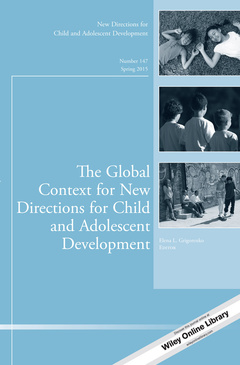Description
The Global Context for New Directions for Child and Adolescent Development
New Directions for Child and Adolescent Development, Number 147
J–B CAD Single Issue Child & Adolescent Development Series
Author: Grigorenko Elena L.
Language: English
Subject for The Global Context for New Directions for Child and...:
Keywords
lene; genomic; merge; science; sciences; explores; intersections; genetics; biopsychosocial; field; approaches; strengthsbased; jessica; health; child; fumiko; article; protective; biopsychosocial development; experiences; evidence; processes
Approximative price 31.03 €
In Print (Delivery period: 12 days).
Add to cart152 p. · 15x22.9 cm · Paperback
Description
/li>Contents
/li>Biography
/li>
- What are some of the “new” directions in the developmental sciences of childhood and adolescence?
- Where will the field be within the next decade or so?
- How do those who practice in the field’s different corners see its trajectory?
This is the 147th volume in this Jossey-Bass series New Directions for Child and Adolescent Development. Its mission is to provide scientific and scholarly presentations on cutting edge issues and concepts in this subject area. Each volume focuses on a specific new direction or research topic and is edited by experts from that field.
Lene Arnett Jensen, Reed W. Larson
Preface 3
Elena L. Grigorenko
1. Genomic Sciences for Developmentalists: A Merge of Science and Practice 5
Elena L. Grigorenko
This essay explores the intersections of genetics/genomics and developmental sciences.
2. Utilizing Biopsychosocial and Strengths-Based Approaches Within the Field of Child Health: What We Know and Where We Can Grow 13
Jessica M. Black, Fumiko Hoeft
This article examines the evidence that early experiences confer both risk and protective processes on biopsychosocial development in childhood and touches on some implications of this dynamic for the life course.
3. Challenges for an Interdisciplinary Consideration of Cognitive Training 21
Damian Patrick Birney
According to this opinion piece, although the debate regarding themalleability of fluid cognitive functions has been ongoing for at least 100 years, more specific research is needed to resolve it.
4. Edutainment, Games, and the Future of Education in a Digital World 33
Linda Jarvin
This brief review examines the literature on edutainment and games, discusses the limits of the current state of research, and proposes research questions investigating broad issues linked to the adaptation of games for education.
5. Bilingualism: Research and Policy 41
Peggy McCardle
This opinion piece provides a brief overview of the education policies and practices regarding bilingualism in the United States and asserts that more complex research is needed to understand the bases of language learning and to put in place (and study) informed policies and practices that can benefit all children, regardless of how many languages they speak or learn.
6. The Utility of Neuroimaging Studies for Informing Educational Practice and Policy in Reading Disorders 49
Jessica M. Black, Chelsea A. Myers, Fumiko Hoeft
Using reading disorder as an example, this essay probes the emerging scientific field of educational neuroscience, which brings together researchers from neuroscience, psychology, and education to explore the neurocognitive processes underlying educational practice and theory.
7. New Directions for the Study of Within-Individual Variability in Development: The Power of “N = 1” 57
Baptiste Barbot, Cyrille Perchec
This article provides an introduction to the idiographic approach (“N = 1” research) in developmental psychology and an overview of the ethodological and statistical techniques employed to address the study of within-individual variability in development.
8. Challenges of Adolescent Psychology in the European Identity Context 69
Lyda Lannegrand-Willems, Baptiste Barbot
This article discusses the European historical context and the current initiatives from the EU that aim to encourage civic engagement among young people.
9. Anger and Globalization Among Young People in India 77
Sonia Suchday
Using India as an example of a fast-globalizing country, this article highlights the experiences and challenges faced by adolescents and emerging adults in the developing world as they strive to establish interpersonal and professional identities.
10. Classroom Research and Child and Adolescent Development in South America 85
David Daniel Preiss, Elisa Calcagni, Valeska Grau
This review examines recent classroom research developed in South America, stressing its relevance to the overall inquiry into child and adolescent development.
11. Adverse Environments and Children’s Creativity Development: Transforming the Notion of “Success in Adversity” in China 93
Li Cheng, Mei Tan, Zhengkui Liu
This article briefly explores the historical sources and modern meaning of “success in adversity,” the strongly held belief in China that individuals who suffer adverse environments can rise to creative excellence and success through persistence.
12. Seeing the Trees Within the Forest: Addressing the Needs of Children Without Parental Care in the Russian Federation 101
Rifkat J. Muhamedrahimov, Elena L. Grigorenko
This essay comments on the current system of care for children growing up without their biological parents and exemplifies different components of this system in the Russian Federation.
13. Cultural Considerations in the Treatment of Mental Illness Among Sexually Abused Children and Adolescents: The Case of Bali, Indonesia 109
Cokorda Bagus J. Lesmana, Luh Ketut Suryani, Niko Tiliopoulos
Using Bali (Indonesia) as a focal culture, this opinion piece discusses the effects of cultural elements and showcases their potential contribution and systematic implementation in a holistic and sensitive interventional model for the treatment of mental illness in childhood and adolescent sexual traumatization.
14. Commentary—Child and Adolescent Development in the Focus of Emerging Developmental Science 117
Sergey A. Kornilov
15. Commentary—A United Front: Using the Range of Psychological Variance in Cutting-Edge Practice and Emerging Research 123
Simon Anthony Jackson, Sabina Kleitman
16. Commentary—Of Quadrants and Fish Scales: Reflections on New Directions in Research in Child and Adolescent Development 127
Jens F. Beckmann
INDEX 135




